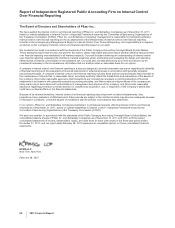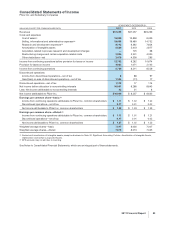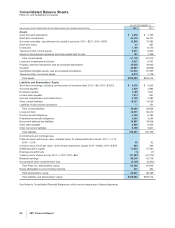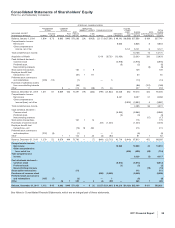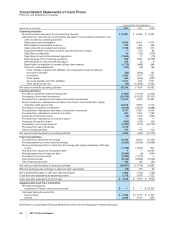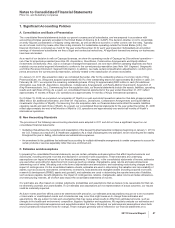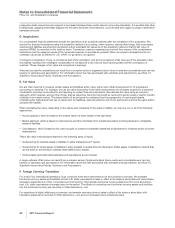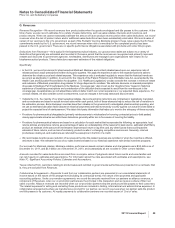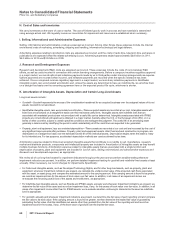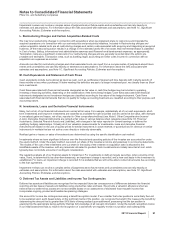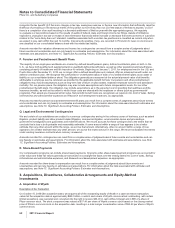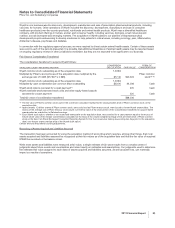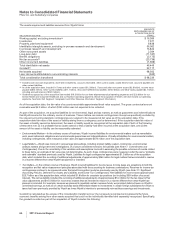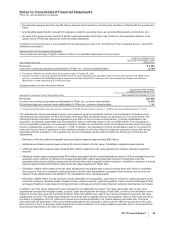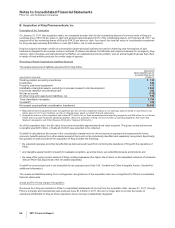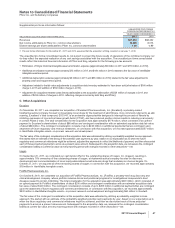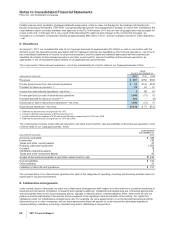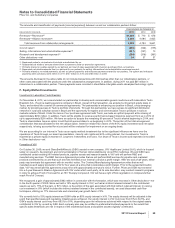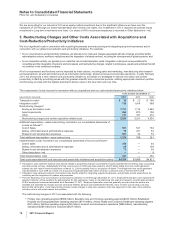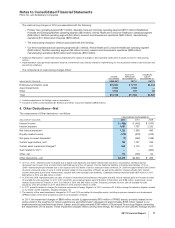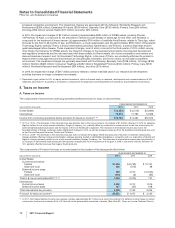Pfizer 2011 Annual Report Download - page 63
Download and view the complete annual report
Please find page 63 of the 2011 Pfizer annual report below. You can navigate through the pages in the report by either clicking on the pages listed below, or by using the keyword search tool below to find specific information within the annual report.
Notes to Consolidated Financial Statements
Pfizer Inc. and Subsidiary Companies
recognize the tax benefit: (i) if there are changes in tax law, analogous case law or there is new information that sufficiently raise the
likelihood of prevailing on the technical merits of the position to more likely than not; (ii) if the statute of limitations expires; or (iii) if
there is a completion of an audit resulting in a favorable settlement of that tax year with the appropriate agency. We regularly
re-evaluate our tax positions based on the results of audits of federal, state and foreign income tax filings, statute of limitations
expirations, changes in tax law or receipt of new information that would either increase or decrease the technical merits of a position
relative to the “more-likely-than-not” standard. Liabilities associated with uncertain tax positions are classified as current only when
we expect to pay cash within the next 12 months. Interest and penalties, if any, are recorded in Provision for taxes on income and
are classified on our consolidated balance sheet with the related tax liability.
Amounts recorded for valuation allowances and income tax contingencies can result from a complex series of judgments about
future events and uncertainties and can rely heavily on estimates and assumptions. For information about the risks associated with
estimates and assumptions, see Note 1C. Significant Accounting Policies: Estimates and Assumptions.
P. Pension and Postretirement Benefit Plans
The majority of our employees worldwide are covered by defined benefit pension plans, defined contribution plans or both. In the
U.S., we have both qualified and supplemental (non-qualified) defined benefit plans, as well as other postretirement benefit plans,
consisting primarily of healthcare and life insurance for retirees. Beginning on January 1, 2011, for employees hired in the U.S. and
Puerto Rico after December 31, 2010, we no longer offer a defined benefit plan and, instead, offer an enhanced benefit under our
defined contribution plan. We recognize the overfunded or underfunded status of each of our defined benefit plans as an asset or
liability on our consolidated balance sheet. The obligations generally are measured at the actuarial present value of all benefits
attributable to employee service rendered, as provided by the applicable benefit formula. Our pension and other postretirement
obligations may include assumptions such as long-term rate of return on plan assets, expected employee turnover and participant
mortality. For our pension plans, the obligation may also include assumptions as to future compensation levels. For our other
postretirement benefit plans, the obligation may include assumptions as to the expected cost of providing the healthcare and life
insurance benefits, as well as the extent to which those costs are shared with the employee or others (such as governmental
programs). Plan assets are measured at fair value. Net periodic benefit costs are recognized, as required, into Cost of sales, Selling,
informational and administrative expenses and Research and development expenses, as appropriate.
Amounts recorded for pension and postretirement benefit plans can result from a complex series of judgments about future events
and uncertainties and can rely heavily on estimates and assumptions. For information about the risks associated with estimates and
assumptions, see Note 1C. Significant Accounting Policies: Estimates and Assumptions.
Q. Legal and Environmental Contingencies
We and certain of our subsidiaries are subject to numerous contingencies arising in the ordinary course of business, such as patent
litigation, product liability and other product-related litigation, commercial litigation, environmental claims and proceedings,
government investigations and guarantees and indemnifications. We record accruals for these contingencies to the extent that we
conclude that a loss is both probable and reasonably estimable. If some amount within a range of loss appears to be a better
estimate than any other amount within the range, we accrue that amount. Alternatively, when no amount within a range of loss
appears to be a better estimate than any other amount, we accrue the lowest amount in the range. We record anticipated recoveries
under existing insurance contracts when recovery is assured.
Amounts recorded for contingencies can result from a complex series of judgments about future events and uncertainties and can
rely heavily on estimates and assumptions. For information about the risks associated with estimates and assumptions, see Note
1C. Significant Accounting Policies: Estimates and Assumptions.
R. Share-Based Payments
Our compensation programs can include share-based payments. All grants under share-based payment programs are accounted for
at fair value and these fair values generally are amortized on a straight-line basis over the vesting terms into Cost of sales, Selling,
informational and administrative expenses, and Research and development expenses, as appropriate.
Amounts recorded for share-based compensation can result from a complex series of judgments about future events and
uncertainties and can rely heavily on estimates and assumptions. For information about the risks associated with estimates and
assumptions, see Note 1C. Significant Accounting Policies: Estimates and Assumptions.
2. Acquisitions, Divestitures, Collaborative Arrangements and Equity-Method
Investments
A. Acquisition of Wyeth
Description of the Transaction
On October 15, 2009 (the acquisition date), we acquired all of the outstanding equity of Wyeth in a cash-and-stock transaction,
valued at the acquisition date at approximately $68.2 billion, in which each share of Wyeth common stock outstanding, with certain
limited exceptions, was canceled and converted into the right to receive $33.00 in cash without interest and 0.985 of a share of
Pfizer common stock. The stock component was valued at $17.40 per share of Wyeth common stock based on the closing market
price of Pfizer’s common stock on the acquisition date, resulting in a total merger consideration value of $50.40 per share of Wyeth
common stock.
62 2011 Financial Report


